Featured Articles
The Fifty Greatest Light-Heavyweights of All Time Part Two – 40-31

Welcome to Part Two of the Greatest Light-Heavyweights of All Time, something of a generational sweep for the last decade with no fewer than four of the ten entrants for Part Two active in the last two years. With no truly dominant figure emerging among Glen Johnson, Bernard Hopkins, Chad Dawson, and Tarver it was inevitable that they would all rank in the same clutch; still, I was surprised to see them ranked in this ten rather than the last ten, or even outside the top fifty all-together.
Having done the groundwork for a similar project at middleweight I can advise that 160lbs has roughly double the depth of 175lbs, but there are reasons for this. Firstly, middleweight is much older and the years upon which light-heavyweight missed out were as rich as any period in fistic history. Even when the division was established fighters and promoters were generally suspicious of it and a fighter weighing 165lbs was far more likely to call himself a contender to the middleweight title than the light-heavyweight title. There was an unhealthy suspicion of anything different in boxing as 1899 became 1900 and the emerging 175lb division was no different.
Having said all that, light-heavyweight produced fewer truly elite boxers than middleweight or welterweight even after it had become enshrined as one of the “original eight”, a mistruth that is told and re-told by modern historians for the sake of convenience. But I personally am glad of a certain lack of depth outside the top twenty-five, it has given me a chance to include champions and contenders who perhaps did not box a career at the weight but were nevertheless extraordinary and deserving of praise.
Beginning with a fighter who quite happily admitted that he was not the best but “just the guy who fought the best.”
#40 – GLEN JOHNSON (54-20-2)
Fifty-four, twenty, and two.
And this isn’t some monstrous battler lurching out of the stacked 1920s division with the scalps of a dozen world-class opponents hanging from his bloodied belt, some hideous fistic bogeyman that enjoyed a murderous prime before suffering some terrible drop off in form and talent as his body betrayed him to drunkenness and women. No, this is a modern day road-warrior who racked up numerous losses at middleweight, super-middleweight, and at light-heavyweight, where our interests lie.
But the career of Glengoffe Johnson, out of Jamaica and in to almost every major boxing nation on earth, is more complex than any set of raw statistics could ever capture.
He stepped up to light-heavyweight in the summer of 2001, stopping Thomas Ulrich in six before meeting Las Vegas regular Derrick Harmon in the Hard Rock. The judges saw it a clear ten round decision in favour of Harmon; the crowd voiced displeasure after what I saw as a narrow win for Johnson. Next up was an ugly loss to former Roy Jones victim Julio Cesar Gonzalez in a razor thin decision that one judge managed to score 98-92. I had it a draw.
Johnson managed an actual draw in his very next fight, with the prospect Daniel Judah; the problem was, Johnson dominated Judah almost bell to bell, clearly losing only one round, the eighth. I scored it, ironically, 98-92. In November of 2011, Johnson travelled to the UK and met ranked tough Clinton Woods and fought a draw in a fight I scored him winner. He lost a rematch in 2006 in a fight that again, looked like a narrow but certain Johnson win. Johnson was twice beaten by Chad Dawson as the decade trundled to an end, but again, I thought he was hard done by in their first fight, a clear win for Johnson and a signal for the crowd, once again, to boo a Glen Johnson loss.
This makes appraising him extremely difficult. Between his arriving in the division in 2001 and the end of 2009, I have him losing just twice, to divisional bosses Antonio Tarver and Chad Dawson – according to paid judges he lost six. The job here is to strike a balance between my sense that Johnson’s career is the most tragic in modern boxing, the inevitable realisation of perhaps the most badly run professional sport in world, a perfect storm of bad luck and bad officiating – and what the men paid to be ringside saw. Fortunately, Johnson props himself up with excellent wins that the officials did manage to see, or, as was the case in his famous detonation of huge favourite Roy Jones Jnr., fights he denied them the right to judge.
Johnson launched himself at Roy Jones and threw punches at parts of his anatomy that Jones wasn’t aware he had. At the end of a particularly aggressive fifth, Orlando Cuellar told a bemused Johnson in his corner that “this is what it will take to win this fight!” Johnson looked like a man who had been told riches beyond his wildest dreams were at his finger-tips if only he could swallow a bull. But Johnson stayed the course. He took the snapping punishment Jones crackled into him and maintained a more tempered version of this attack for the rounds that followed, bulldozing Jones into unconsciousness in the ninth. Jones had already been defeated by Antonio Tarver, setting up a showdown between him and Johnson, a showdown Johnson won making him the premier light-heavyweight in the world.
It is enough, along with victories over ranked men Clinton Woods and Eric Harding to place him under consideration for a top fifty spot; the injustice that served him throughout a career fought on the road sees him ranked here at the bottom end of the second ten. Some may not care for this elevated ranking given the losses he suffered, but it is my contention that Johnson is inarguably a better and more significant fighter than his paper record allows.
#39 – GUS LESNEVICH (60-14-5)
Depending upon your point of view, Gus Lesnevich either committed perhaps the most shameful duck in the history of the light-heavyweight title or was a fighter whose legacy was compromised by the outbreak of World War Two. After being thrashed by Jimmy Bivins in a non-title match in 1942, manager Lew Diamond told press that there would be no chance of a rematch between Bivins and Lesnevich. Lesnevich disappeared into the war-time coastguard – his title frozen for the duration, he remained true to his manager’s word. What this adds up to is a title reign of around seven years – but one which encompassed a total of only five successful defences against only three different fighters.
Nevertheless there is much to admire about Lesnevich, not least an outstanding persistence and hearty directness that earned him status as a fan favourite. Thrashed by Billy Conn in his first title shot in November of 1939, Lesnevich was so popular that he was handed a second title shot in the summer of the following year. Beaten again, he nevertheless was able to win more than the four rounds generally reported in the first fight, and it can have been of little surprise when Lesnevich received a third title shot a year later, this time beating out Anton Christoforidis. After making two successful defences against the unranked Tami Mauriello (the first of them desperately close) and the beating at the hands of Jimmy Bivins, the service got Lesnevich and when he re-emerged in 1946 it was thought that he, like peers Billy Conn and Joe Louis, would have left his best behind him. This seemed confirmed when he was smashed out by Bruce Woodcock up at heavyweight, the only time in his career that Lesnevich heard the ten. But Lesnevich came again, and in fact was the Ring fighter of the year in 1947. His brutal stoppage of British rival Freddie Mills, as savage a knockout as can be seen on film, was likely the highlight of this second career; but it was Mills who would take the title from him in 1948 over fifteen after a torrid first round that left Lesnevich cut and hurt.
Other fine wins over contenders like Alabama Kid, Ambrose Palmer and Billy Fox help nurse a ranking earned in the main with elbow grease and hard work.
#38 – AL GAINER (77-23)
Al Gainer’s record against the best he faced makes awkward reading. He went 1-1-1 with Tiger Jack Fox; 1-2 with Lou Brouillard; 2-2-1 with Bob Olin, 1-1 with Al McCoy and 1-1 with George Courtney. Splitting a series with Tiger Jack Fox speaks for, not against him, but the Brouillard series is troubling. The Canadian was a middleweight really, and one that had failed on three occasions to best Marcel Thil. Nevertheless, he twice dominated Gainer and for all that Gainer defeated him “easily” in their middle encounter, Brouillard clearly deserved the victory in their series. Aspects of his confrontation with Olin were more debatable but still, Gainer failed to prove his superiority over Olin just as he did Brouillard. Sometimes Gainer’s failure to equalise these fights with what was perhaps the best left hook of the era seems curious, although such matters are abandoned forever to the realm of speculation.
That left hook did, in part, bring him wins over Olin, McCoy, Brouillard and Courtney and that shouldn’t be forgotten for all that his overall record against them feels somewhat underwhelming. He also pounded out a one-sided victory over Joe Knight and several other solid contenders of this era, from Clyde Chastain to Lou Scozza and Dave Shade. Often his displays were dominant, but he, in turn, was dominated by Tony Shucco. They met four times and Gainer failed to return a single victory.
It is this last that in the end leads me to reject Herb Goldman’s ranking of Al Gainer at #25. Gainer was special and names among the most outstanding fighters never to have earned the crown but a place in the top thirty must be beyond him based upon his actual track record.
On the other hand, he was ranked for an entire decade, the 1930s, mostly in the lower reaches of the Ring top ten, but present none-the-less. This, in keeping with a consistently high level of competition smuggles him in to the top forty – but no more for the once sparkling Al Gainer.
#37 – BERNARD HOPKINS (55-7-2)
As ridiculous as it seems now, the twin defeats of Bernard Hopkins by Jermain Taylor in 2005 was seen as something of a terminal for the great middleweight. If not quite finished, he had perhaps boarded the great train to nowhere, even if there was to be a quick stop at light-heavyweight for a beating at the hands of three to one favourite Antonio Tarver. As is so often the case in boxing, the unexpected occurred: Hopkins kicked the shit out of Tarver.
Tarver had had his problems in training, dropping forty pounds he had gained for a performance in a movie while Hopkins, of course, was moving up. It is this writer’s opinion that no practice in boxing hurts a fighter so much as weight-making, and here was yet another beautiful demonstration of that fact. No longer shackled by the manacles of 160lbs, Hopkins weighed in at a liberating 174lbs and re-hydrated to a luscious 182lbs. It was like putting fuel in. He threw almost one-hundred more punches than he had managed in the first Taylor fight and found Tarver with the old unerring accuracy. Inside, he was clearly the stronger man despite being both smaller and older while on the outside he took by far the more steps but his engine remained greased. Aged forty-one years of age, Bernard’s astonishing assault on the light-heavyweight division had begun.
Truly, these past eight years have had their peaks and valleys, but despite a winding road, Hopkins never stepped off the path that led to and through ranked men, except when he was thrashing the undisputed middleweight champion Kelly Pavlik, or losing a desperately close fight to pound-for-pounder Joe Calzaghe. It looks like that journey has finally come to an end with a dispiriting, damaging loss against the excellent Sergey Kovalev but I can’t imagine marching into a bookmaker and actually laying a bet against Hopkins scraping together a couple more wins against good opposition in this division in 2015 – and perhaps even gaining another spot on this list.
#36 – MICKEY WALKER (94-19-4; Newspaper Decisions 37-6-2)
The absurd Toy Bulldog, Mickey Walker, would have fought a truck piloted by a meth-fuelled werewolf if the money was right. He was crazy.
He slipped his way onto my top 100 at heavyweight, at #94 no less, and his heroics in that division are well documented. Less well respected are his achievements at light-heavyweight, which is a shame, because they are outstanding. Although he never held the title himself, he defeated not one, not two, but three legitimate light-heavyweight champions of the world. Mike McTigue went first in 1925, the reigning title-holder but willing to meet Walker only in a twelve-round no-decision bout, Walker in need of a knockout in order to lift the title. The Bulldog pounded out a twelve round newspaper decision but couldn’t put his man away; infuriatingly, Walker knocked McTigue, an underrated but carefully nursed champion, quite literally out to dry, hanging him over the second rope in a single round in 1927 – by which time he had been parted from the title.
After his overdue knockout of McTigue, Walker, absolutely no light-heavyweight at 5’7 and a great deal of history at welterweight and middleweight, bowled right into the wonderful Paul Berlenbach, who had lost his title to Jack Delaney just a year earlier. Barely over the middleweight limit, Walker gave away eleven pounds to Delaney who was a body-puncher and boxer of real repute – Walker won “every round” and gave his man “an unmerciful beating” according to The Montreal Gazette, even forcing the bigger man to the canvas with his indomitable left.
Last up was Maxie Rosenbloom. Rosenbloom, inevitably, won the championship match between the two but Walker dropped and bettered the champion in a non-title bout a few months later. It was the second time he had defeated a reigning light-heavyweight champion and he had done so an astonishing seven years apart.
Between, he had dropped a split-decision lost to the great Tommy Loughran and twice bested Leo Lomski. It wasn’t quite meant to be for Walker at light-heavyweight – but few fighters have bested more lineal champions than he.
#35 – CHAD DAWSON (32-4)
All but finished at thirty-two years of age Chad Dawson was obliterated in a single round by Adonis Stevenson in 2013, out-fought by Jean Pascal in 2010 and narrowly edged by Nathan Cleverly victim Tommy Karpency in ten rounds towards the end of 2014. The other hand is weighed heavily in his favour, however. Dawson holds two wins over Glen Johnson, two wins over Antonio Tarver and a win over Bernard Hopkins making him a proud holder of victories over every post-Jones pre-Kovalev light-heavyweight of genuine significance apart from Zsolt Erdei, whose history of avoiding name fighters is legendary. His supplementary wins, too, are superb. He handed 31-0 Tomasz Adamek his first loss; clambered off the canvas to defeat the era’s elite gatekeeper Eric Harding in a bloody, absorbing contest; and firmly outpointed the ranked Adrian Diaconu. I will be frank: I don’t personally care for Dawson as a fighter, in hype, style or fistic class, but leaving him out is impossible and given his thorough defeat of Bernard Hopkins and a resume that is likely superior to The Executioner’s, the disturbing nature of some of his losses can be ignored. He slips in here ahead of both Hopkins and Glen Johnson, despite my personal preference for both.
This, more than any other single factor probably indicates that Dawson has earned his ranking. The facts of the case outweigh my feelings.
#34 – JIMMY SLATTERY (111-13; Newspaper Decisions 3-0)
Welcome our first legitimate centurion, Jimmy Slattery, who stopped a total of forty-nine opponents and won sixty-two decisions.
A lot of this work was done at middleweight where Slattery served a long apprenticeship between 1921, when he turned professional, and 1925, when he began to probe the division above. These early advances bore surprisingly ripe fruit as Slattery netted wins over under-developed legends of the poundage, first Jack Delaney and then Maxie Rosenbloom both over the distance of six rounds – but Slattery’s domination of the blooming Rosenbloom continued into 1926 and 1927 by which time Rosenbloom was ranked at the top of the division. This domination ended, however, when Max came to the title. Always a better fighter with the legitimate championship at his waist, Rosenbloom consistently out-scrambled Slattery when it came to that prize.
Slattery held a strap but never a lineage. He inevitably lost to the wonderful Tommy Loughran, too, but was able to scrape past the superb Lou Scozza with the NYSAC title on the line.
He never really delivered on that astonishing early promise. Part of the problem was that he lived like boxed – on his toes but in search of trouble, a fighter that led the life of a rogue and so could never reach his potential as a boxer. Winning a series with Rosenbloom is impressive but it must be said that every top light-heavy of the era seems to have beaten Max at some point – my feeling is that despite an impressive haul of scalps at 175lbs, Slattery doesn’t quite belong up there with the very best.
#33 – JOEY MAXIM (82-29-4)
A grim persistence on the inside combined with a technical surety on the outside, an iron jaw and staid discipline saw Joey Maxim carve out one of boxing’s most underrated careers – but a huge and surprising amount of his best work was done at heavyweight. Maxim was tackling these bigger men as early as his first year and as we have seen, time spent above 180lbs or matching these bigger men at a lighter weight impacts the standing of light-heavyweights because they cease to box in light-heavyweight contests.
But Maxim was the champion of the world at light-heavyweight, coming to the title in 1951, ten long, hard years after he turned professional. He was never going to hold it long with Archie Moore lurking in the brutal shadows of the murderer’s row, but Maxim should be credited for tackling the universally ducked Moore in the first place – and for the work he did in the division before Moore reached him.
He took the title from Freddie Mills who reportedly lost three teeth and never boxed again as Maxim jabbed and hooked him into retirement. Not a puncher, his unerring consistency, accuracy and a persistence born of great durability and strength of character could nevertheless inflict severe suffering on all but the very best opponents. Certainly he had been too much for Gus Lesnevich, dominating him over fifteen rounds eight months earlier as he was for favourite Bob Murphy in his first title defence.
His third defence was far and away his most famous fight, Maxim defeating Sugar Ray Robinson in thirteen rounds as the middleweight champion of the world quit in appalling conditions, the heat in the ring said to be over one-hundred degrees Fahrenheit. Maxim never received credit for this win – Robinson weighed in as a middleweight, and the heat rather than Maxim was perceived as Robinson’s chief foe (Robinson himself naming the source of his defeat as God himself, perhaps demonstrating the kind of self-belief necessary to blaze a trail from lightweight all the way to light-heavyweight). This is perhaps a little unfair. As Maxim remarked, “did people think I had air conditioning in my corner?” It was a victory for durability and size but it was a victory none the less, for all that it is a difficult one to judge. I’ve treated it here as a successful defence against a dangerous but unranked opponent. Robinson was certainly that, taking the lion’s share of the rounds before he was pulled.
Then Moore came calling and Maxim’s time at the top was over. Maxim wasn’t so much out-classed by Moore as seemingly incapable of winning rounds, many of which were close but almost all of which seemed to be controlled by The Mongoose. Maxim fought Moore three times and at no time recorded a win.
Outside of those title fights, Maxim’s best wins at the weight were likely over Nate Bolden and the wonderful if inexperienced Floyd Patterson but Maxim spent so little time actually boxing against light-heavyweights at light-heavyweight that he must even so rank in the thirties, rather lower than I expected to see him. Any Maxim fans who are disappointed in this could do a lot worse than to track down my heavyweight list, where Maxim’s ranking is surprisingly high.
#32 – EDDIE MUSTAFA MUHAMMAD(50-8-1)
Eddie Mustafa Muhammad was dropped in the first round of his 1977 contest with Matthew Saad Muhammad but fought his way back to take a narrow, disputed decision on the scorecards. It was a battle of the greenhorns, and their friendship and shared religion would keep them from ever meeting in their respective primes, but both men carved out extraordinary careers independent of one-another. Eddie Mustafa would forever remain the poorer cousin in terms of legacy but he had his own great moments, not least in losing in his premature title shot against Victor Galindez later that same year. Eddie boxed with such patience, with such maturity that he belied his 22-2-1 record dropping a narrow decision against a wonderful world champion, first jabbing, then introducing the right hand, ending in a tactical stalk that fell just short of enough.
In the last round he showed a strange passivity however that was his greatest weakness. Against the colourful James Scott who forged a famous career from behind the bars of Rahway State Prison he boxed shamefully, holding and stalling his way to an inexplicable and wide decision loss. This postponed what had seemed an inevitable title shot for eighteen months, although when it came, against the deadly Marvin Johnson, he grabbed it with both hands, dominating and stopping the out-gunned champion. When he was on, Eddie was outstanding, but he could be placed under control both by counterpunchers and by maulers and when he was tempted, like so many light-heavyweight champions before and after him, by heavyweight riches, he perhaps gave way to his failings permanently. Beefing up to an absurd 200lbs, he followed a careful Renaldo Snipes around the ring for ten rounds dropping a decision over ten. When he had to drain his way back down to 175lbs to meet the brilliant Michael Spinks he left himself chanceless in what was his third title defence, fading down the stretch, a certain passivity beaten into his work by a Spinks who boxed rampantly in the second half of the fight.
“Not a natural fighter” is how old-timers probably would have diagnosed Eddie and although a little harsh, it might be about right. Certainly not fearful of absorbing punishment, he could be beaten or boxed into a kind of premature submission and that hurts his legacy and my appraisal of him head to head. But he had a superb body-attack is an under-appreciated counter-puncher and a good hitter. Even after the twin debacles versus Snipes and Spinks he remained a formidable fighter, his vicious, surreal knockout of the excellent Lottie Mwale probably the highlight. Certainly he belongs on this list, but a nagging sense that he failed to fulfil his potential remains.
#31 – ANTONIO TARVER (31-6)
Tarver’s elevated position here will be troubling to traditionalist readers but for those men (you never hear it from the fairer, more balanced sex) I have two words: Roy Jones.
Beating Roy Jones is like beating Archie Moore or Harold Johnson. Jones was incredible, a Phenom, a monster, a terrifying mix of power and speed who appeared, from middleweight to heavyweight, the complete superior of all he shared the ring with. The first man to lay him low was always going to establish himself in the annals of history and Tarver has done so.
The first fight was a close decision in favour of Jones, but Roy had been put through his paces, made to fight the fight of his career, Tarver allowing himself to be pushed gently form the box-seat in rounds three to five, Jones fighting to hold it in the eleventh and twelfth. A rematch was inevitable and it is one of the more famous nights in the modern history of the light-heavyweight division. Knocked brutally, unreservedly, spectacularly out by a Tarver left-hand, Roy sat glassy-eyed as Tarver celebrated so raucously that he appeared to inadvertently damage a camera and camera-man; that even Don King seemed reluctant to approach and ingratiate. Immediately, people set out to discredit Tarver – some even produced photographs that appeared to suggest that Tarver “had his eyes closed” when he threw the “lucky punch” that signalled time on one of the greatest ring careers fought entirely in colour, ignoring the beauty of the counter that Tarver unleashed while under fire. So Tarver beat Roy Jones again in a strange and distant fight in which Roy Jones hardly threw and Tarver quietly out-hustled him with economy, patience and an almost uncanny ability to rush the easily startled Jones with near perfect timing.
Tarver was a 6’2 defensively sound southpaw with good athletic ability, and a fine head for distance for all that he could sometimes throw himself off-balance with over-enthusiastic lurching punches, and probably is underestimated in terms of skillset and head-to-head appraisement. In addition to his domination of the series with Jones, Tarver’s most interesting performance may be his revenge TKO of Eric Harding. Harding and Tarver were both inexperienced when they first met in 2000 and went blow-for-blow up until the final third of the fight when Tarver, having suffered a broken jaw at the hands of his surprisingly aggressive opponent, went into survival mode. It was his bravest performance and in many ways I think it made him. By the time of their rematch in 2002 Tarver was a different kind of fighter, exhibiting all that patience and trickery he showed in his third contest with Jones; he took Harding out in five.
Excellent while dominating the veterans Reggie Johnson, Clinton Woods and Montell Griffin, superb in handing Glen Johnson what was arguably the first legitimate loss of Johnson’s light-heavyweight career, Tarver has built a good resume independent of Jones; but those are the wins that absolutely root him in the thirties. Is it possible he cashed in on the decline of Jones to earn his spot? Yes – but it’s always difficult to push a Ferrari off the cliff.
Featured Articles
Avila Perspective, Chap. 323: British Family Feud and More

ext generation rivals Conor Benn and Chris Eubank Jr. carry on the family legacy of feudal warring in the prize ring on Saturday.
This is huge in British boxing.
Eubank (34-3, 25 KOs) holds the fringe IBO middleweight title but won’t be defending it against the smaller welterweight Benn (23-0, 14 KOs) on Saturday, April 26, at Tottenham Hotspur Stadium in London. DAZN will stream the Matchroom Boxing card.
This is about family pride.
The parents of Eubank and Benn actually began the feud in the 1990s.
Papa Nigel Benn fought Papa Chris Eubank twice. Losing as a middleweight in November 1990 at Birmingham, England, then fighting to a draw as a super middleweight in October 1993 in Manchester. Both were world title fights.
Eubank was undefeated and won the WBO middleweight world title in 1990 against Nigel Benn by knockout. He defended it three times before moving up and winning the vacant WBO super middleweight title in September 1991. He defended the super middleweight title 14 times until suffering his first pro defeat in March 1995 against Steve Collins.
Benn won the WBO middleweight title in April 1990 against Doug DeWitt and defended it once before losing to Eubank in November 1990. He moved up in weight and took the WBC super middleweight title from Mauro Galvano in Italy by technical knockout in October 1992. He defended the title nine times until losing in March 1996. His last fight was in November 1996, a loss to Steve Collins.
Animosity between the two families continues this weekend in the boxing ring.
Conor Benn, the son of Nigel, has fought mostly as a welterweight but lately has participated in the super welterweight division. He is several inches shorter in height than Eubank but has power and speed. Kind of a British version of Gervonta “Tank” Davis.
“It’s always personal, every opponent I fight is personal. People want to say it’s strictly business, but it’s never business. If someone is trying to put their hands on me, trying to render me unconscious, it’s never business,” said Benn.
This fight was scheduled twice before and cut short twice due to failed PED tests by Benn. The weight limit agreed upon is 160 pounds.
Eubank, a natural middleweight, has exchanged taunts with Benn for years. He recently avenged a loss to Liam Smith with a knockout victory in September 2023.
“This fight isn’t about size or weight. It’s about skill. It’s about dedication. It’s about expertise and all those areas in which I excel in,” said Eubank. “I have many, many more years of experience over Conor Benn, and that will be the deciding factor of the night.”
Because this fight was postponed twice, the animosity between the two feuding fighters has increased the attention of their fans. Both fighters are anxious to flatten each other.
“He’s another opponent in my way trying to crush my dreams. trying to take food off my plate and trying to render me unconscious. That’s how I look at him,” said Benn.
Eubank smiles.
“Whether it’s boxing, whether it’s a gun fight. Defense, offense, foot movement, speed, power. I am the superior boxer in each of those departments and so many more – which is why I’m so confident,” he said.
Supporting Bout
Former world champion Liam Smith (33-4-1, 20 KOs) tangles with Ireland’s Aaron McKenna (19-0, 10 KOs) in a middleweight fight set for 12 rounds on the Benn-Eubank undercard in London.
“Beefy” Smith has long been known as one of the fighting Smith brothers and recently lost to Eubank a year and a half ago. It was only the second time in 38 bouts he had been stopped. Saul “Canelo” Alvarez did it several years ago.
McKenna is a familiar name in Southern California. The Irish fighter fought numerous times on Golden Boy Promotion cards between 2017 and 2019 before returning to the United Kingdom and his assault on continuing the middleweight division. This is a big step for the tall Irish fighter.
It’s youth versus experience.
“I’ve been calling for big fights like this for the last two or three years, and it’s a fight I’m really excited for. I plan to make the most of it and make a statement win on Saturday night,” said McKenna, one of two fighting brothers.
Monster in L.A.
Japan’s super star Naoya “Monster” Inoue arrived in Los Angeles for last day workouts before his Las Vegas showdown against Ramon Cardenas on Sunday May 4, at T-Mobile Arena. ESPN will televise and stream the Top Rank card.
It’s been four years since the super bantamweight world champion performed in the US and during that time Naoya (29-0, 26 KOs) gathered world titles in different weight divisions. The Japanese slugger has also gained fame as perhaps the best fighter on the planet. Cardenas is 26-1 with 14 KOs.
Pomona Fights
Super featherweights Mathias Radcliffe (9-0-1) and Ezequiel Flores (6-4) lead a boxing card called “DMG Night of Champions” on Saturday April 26, at the historic Fox Theater in downtown Pomona, Calif.
Michaela Bracamontes (11-2-1) and Jesus Torres Beltran (8-4-1) will be fighting for a regional WBC super featherweight title. More than eight bouts are scheduled.
Doors open at 6 p.m. For ticket information go to: www.tix.com/dmgnightofchampions
Fights to Watch
Sat. DAZN 9 a.m. Conor Benn (23-0) vs Chris Eubank Jr. (34-3); Liam Smith (33-4-1) vs Aaron McKenna (19-0).
To comment on this story in the Fight Forum CLICK HERE
Featured Articles
Floyd Mayweather has Another Phenom and his name is Curmel Moton
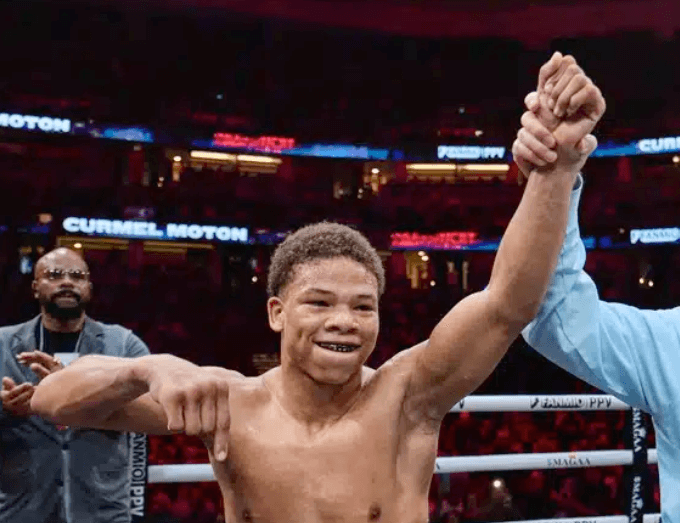
Floyd Mayweather has Another Phenom and his name is Curmel Moton
In any endeavor, the defining feature of a phenom is his youth. Philadelphia Phillies outfielder Bryce Harper was a phenom. He was on the radar screen of baseball’s most powerful player agents when he was 14 years old.
Curmel Moton, who turns 19 in June, is a phenom. Of all the young boxing stars out there, wrote James Slater in July of last year, “Curmel Moton is the one to get most excited about.”
Moton was born in Salt Lake City, Utah. His father Curtis Moton, a barber by trade, was a big boxing fan and specifically a big fan of Floyd Mayweather Jr. When Curmel was six, Curtis packed up his wife (Curmel’s stepmom) and his son and moved to Las Vegas. Curtis wanted his son to get involved in boxing and there was no better place to develop one’s latent talents than in Las Vegas where many of the sport’s top practitioners came to train.
Many father-son relationships have been ruined, or at least frayed, by a father’s unrealistic expectations for his son, but when it came to boxing, the boy was a natural and he felt right at home in the gym.
The gym the Motons patronized was the Mayweather Boxing Club. Curtis took his son there in hopes of catching the eye of the proprietor. “Floyd would occasionally drop by the gym and I was there so often that he came to recognize me,” says Curmel. What he fails to add is that the trainers there had Floyd’s ear. “This kid is special,” they told him.
It costs a great deal of money for a kid to travel around the country competing in a slew of amateur boxing tournaments. Only a few have the luxury of a sponsor. For the vast majority, fund raisers such as car washes keep the wheels greased.
Floyd Mayweather stepped in with the financial backing needed for the Motons to canvas the country in tournaments. As an amateur, Curmel was — take your pick — 156-7 or 144-6 or 61-3 (the latter figure from boxrec). Regardless, at virtually every tournament at which he appeared, Curmel Moton was the cock of the walk.
Before the pandemic, Floyd Mayweather Jr had a stable of boxers he promoted under the banner of “The Money Team.” In talking about his boxers, Floyd was understated with one glaring exception – Gervonta “Tank” Davis, now one of boxing’s top earners.
When Floyd took to praising Curmel Moton with the same effusive language, folks stood up and took notice.
Curmel made his pro debut on Sept. 30, 2023, at the T-Mobile Arena in Las Vegas on the undercard of the super middleweight title fight between Canelo Alvarez and Jermell Charlo. After stopping his opponent in the opening round, he addressed a flock of reporters in the media room with Floyd standing at his side. “I felt ready,” he said, “I knew I had Floyd behind me. He believes in me. I had the utmost confidence going into the fight. And I went in there and did what I do.”
Floyd ventured the opinion that Curmel was already a better fighter than Leigh Wood, the reigning WBA world featherweight champion who would successfully defend his belt the following week.
Moton’s boxing style has been described as a blend of Floyd Mayweather and Tank Davis. “I grew up watching Floyd, so it’s natural I have some similarities to him,” says Curmel who sparred with Tank in late November of 2021 as Davis was preparing for his match with Isaac “Pitbull” Cruz. Curmell says he did okay. He was then 15 years old and still in school; he dropped out as soon as he reached the age of 16.
Curmel is now 7-0 with six KOs, four coming in the opening round. He pitched an 8-round shutout the only time he was taken the distance. It’s not yet official, but he returns to the ring on May 31 at Mandalay Bay in Las Vegas where Caleb Plant and Jermall Charlo are co-featured in matches conceived as tune-ups for a fall showdown. The fight card will reportedly be free for Amazon Prime Video subscribers.
Curmel’s presumptive opponent is Renny Viamonte, a 28-year-old Las Vegas-based Cuban with a 4-1-1 (2) record. It will be Curmel’s first professional fight with Kofi Jantuah the chief voice in his corner. A two-time world title challenger who began his career in his native Ghana, the 50-year-old Jantuah has worked almost exclusively with amateurs, a recent exception being Mikaela Mayer.
It would seem that the phenom needs a tougher opponent than Viamonte at this stage of his career. However, the match is intriguing in one regard. Viamonte is lanky. Listed at 5-foot-11, he will have a seven-inch height advantage.
Keeping his weight down has already been problematic for Moton. He tipped the scales at 128 ½ for his most recent fight. His May 31 bout, he says, will be contested at 135 and down the road it’s reasonable to think he will blossom into a welterweight. And with each bump up in weight, his short stature will theoretically be more of a handicap.
For fun, we asked Moton to name the top fighter on his pound-for-pound list. “[Oleksandr] Usyk is number one right now,” he said without hesitation,” great footwork, but guys like Canelo, Crawford, Inoue, and Bivol are right there.”
It’s notable that there isn’t a young gun on that list. Usyk is 38, a year older than Crawford; Inoue is the pup at age 32.
Moton anticipates that his name will appear on pound-for-pound lists within the next two or three years. True, history is replete with examples of phenoms who flamed out early, but we wouldn’t bet against it.
To comment on this story in the Fight Forum CLICK HERE
Featured Articles
Arne’s Almanac: The First Boxing Writers Assoc. of America Dinner Was Quite the Shindig
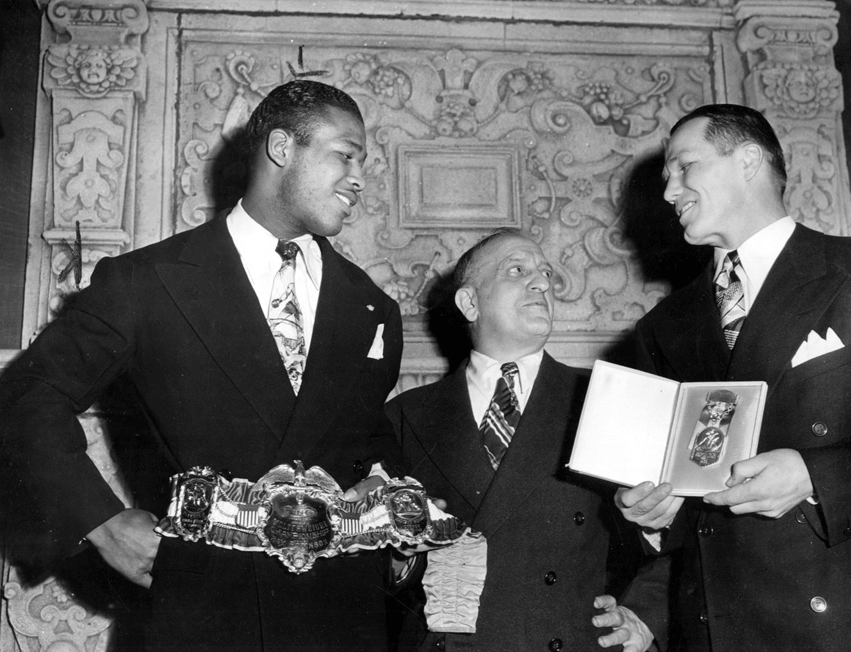
The first annual dinner of the Boxing Writers Association of America was staged on April 25, 1926 in the grand ballroom of New York’s Hotel Astor, an edifice that rivaled the original Waldorf Astoria as the swankiest hotel in the city. Back then, the organization was known as the Boxing Writers Association of Greater New York.
The ballroom was configured to hold 1200 for the banquet which was reportedly oversubscribed. Among those listed as agreeing to attend were the governors of six states (New York, New Jersey, Massachusetts, Pennsylvania, Connecticut, and Maryland) and the mayors of 10 of America’s largest cities.
In 1926, radio was in its infancy and the digital age was decades away (and inconceivable). So, every journalist who regularly covered boxing was a newspaper and/or magazine writer, editor, or cartoonist. And at this juncture in American history, there were plenty of outlets for someone who wanted to pursue a career as a sportswriter and had the requisite skills to get hired.
The following papers were represented at the inaugural boxing writers’ dinner:
New York Times
New York News
New York World
New York Sun
New York Journal
New York Post
New York Mirror
New York Telegram
New York Graphic
New York Herald Tribune
Brooklyn Eagle
Brooklyn Times
Brooklyn Standard Union
Brooklyn Citizen
Bronx Home News
This isn’t a complete list because a few of these papers, notably the New York World and the New York Journal, had strong afternoon editions that functioned as independent papers. Plus, scribes from both big national wire services (Associated Press and UPI) attended the banquet and there were undoubtedly a smattering of scribes from papers in New Jersey and Connecticut.
Back then, the event’s organizer Nat Fleischer, sports editor of the New York Telegram and the driving force behind The Ring magazine, had little choice but to limit the journalistic component of the gathering to writers in the New York metropolitan area. There wasn’t a ballroom big enough to accommodate a good-sized response if he had extended the welcome to every boxing writer in North America.
The keynote speaker at the inaugural dinner was New York’s charismatic Jazz Age mayor James J. “Jimmy” Walker, architect of the transformative Walker Law of 1920 which ushered in a new era of boxing in the Empire State with a template that would guide reformers in many other jurisdictions.
Prizefighting was then associated with hooligans. In his speech, Mayor Walker promised to rid the sport of their ilk. “Boxing, as you know, is closest to my heart,” said hizzoner. “So I tell you the police force is behind you against those who would besmirch or injure boxing. Rowdyism doesn’t belong in this town or in your game.” (In 1945, Walker would be the recipient of the Edward J. Neil Memorial Award given for meritorious service to the sport. The oldest of the BWAA awards, the previous recipients were all active or former boxers. The award, no longer issued under that title, was named for an Associated Press sportswriter and war correspondent who died from shrapnel wounds covering the Spanish Civil War.)
Another speaker was well-traveled sportswriter Wilbur Wood, then affiliated with the Brooklyn Citizen. He told the assembly that the aim of the organization was two-fold: to help defend the game against its detractors and to promote harmony among the various factions.
Of course, the 1926 dinner wouldn’t have been as well-attended without the entertainment. According to press dispatches, Broadway stars and performers from some of the city’s top nightclubs would be there to regale the attendees. Among the names bandied about were vaudeville superstars Sophie Tucker and Jimmy Durante, the latter of whom would appear with his trio, Durante, (Lou) Clayton, and (Eddie) Jackson.
There was a contraction of New York newspapers during the Great Depression. Although empirical evidence is lacking, the inaugural boxing writers dinner was likely the largest of its kind. Fifteen years later, in 1941, the event drew “more than 200” according to a news report. There was no mention of entertainment.
In 1950, for the first time, the annual dinner was opened to the public. For $25, a civilian could get a meal and mingle with some of his favorite fighters. Sugar Ray Robinson was the Edward J. Neil Award winner that year, honored for his ring exploits and for donating his purse from the Charlie Fusari fight to the Damon Runyon Cancer Fund.
There was no formal announcement when the Boxing Writers Association of Greater New York was re-christened the Boxing Writers Association of America, but by the late 1940s reporters were referencing the annual event as simply the boxing writers dinner. By then, it had become traditional to hold the annual affair in January, a practice discontinued after 1971.
The winnowing of New York’s newspaper herd plus competing banquets in other parts of the country forced Nat Fleischer’s baby to adapt. And more adaptations will be necessary in the immediate future as the future of the BWAA, as it currently exists, is threatened by new technologies. If the forthcoming BWAA dinner (April 30 at the Edison Ballroom in mid-Manhattan) were restricted to wordsmiths from the traditional print media, the gathering would be too small to cover the nut and the congregants would be drawn disproportionately from the geriatric class.
Some of those adaptations have already started. Last year, Las Vegas resident Sean Zittel, a recent UNLV graduate, had the distinction of becoming the first videographer welcomed into the BWAA. With more and more people getting their news from sound bites, rather than the written word, the videographer serves an important function.
The reporters who conducted interviews with pen and paper have gone the way of the dodo bird and that isn’t necessarily a bad thing. A taped interview for a “talkie” has more integrity than a story culled from a paper and pen interview because it is unfiltered. Many years ago, some reporters, after interviewing the great Joe Louis, put words in his mouth that made him seem like a dullard, words consistent with the Sambo stereotype. In other instances, the language of some athletes was reconstructed to the point where the reader would think the athlete had a second job as an English professor.
The content created by videographers is free from that bias. More of them will inevitably join the BWAA and similar organizations in the future.
Photo: Nat Fleischer is flanked by Sugar Ray Robinson and Tony Zale at the 1947 boxing writers dinner.
-
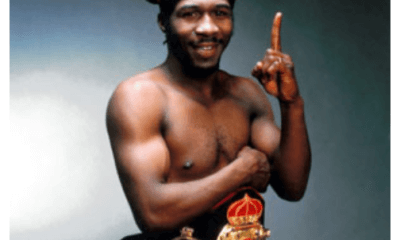
 Featured Articles4 weeks ago
Featured Articles4 weeks agoBoxing Odds and Ends: The Wacky and Sad World of Livingstone Bramble and More
-
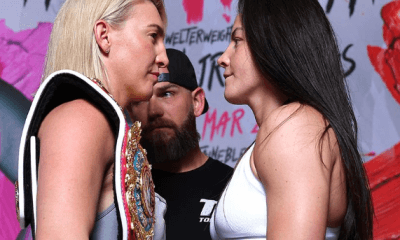
 Featured Articles4 weeks ago
Featured Articles4 weeks agoAvila Perspective, Chap. 319: Rematches in Las Vegas, Cancun and More
-

 Featured Articles4 weeks ago
Featured Articles4 weeks agoRingside at the Fontainebleau where Mikaela Mayer Won her Rematch with Sandy Ryan
-
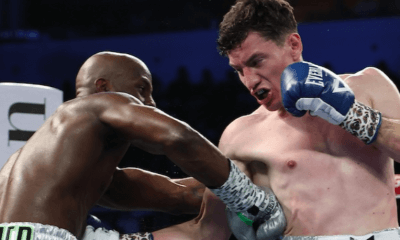
 Featured Articles4 weeks ago
Featured Articles4 weeks agoWilliam Zepeda Edges Past Tevin Farmer in Cancun; Improves to 34-0
-
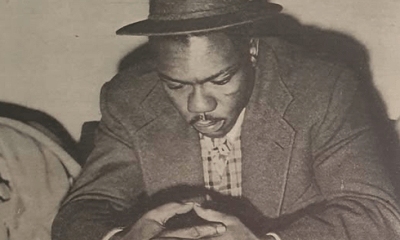
 Featured Articles3 weeks ago
Featured Articles3 weeks agoHistory has Shortchanged Freddie Dawson, One of the Best Boxers of his Era
-
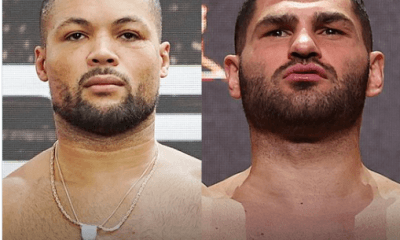
 Featured Articles3 weeks ago
Featured Articles3 weeks agoAvila Perspective, Chap. 320: Women’s Boxing Hall of Fame, Heavyweights and More
-
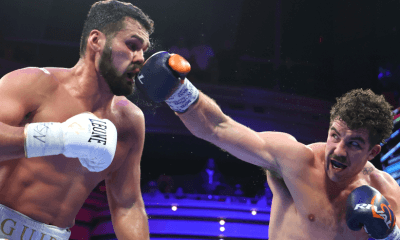
 Featured Articles3 weeks ago
Featured Articles3 weeks agoResults and Recaps from Las Vegas where Richard Torrez Jr Mauled Guido Vianello
-
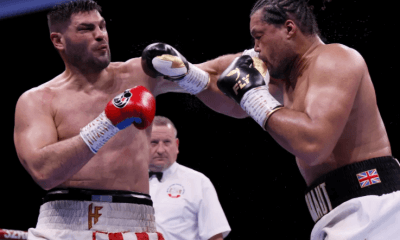
 Featured Articles3 weeks ago
Featured Articles3 weeks agoFilip Hrgovic Defeats Joe Joyce in Manchester















